City of Benares

Ellerman City Line
In Memory of the children who did not come home
Hitler's War against women and children see also
Athenia
|
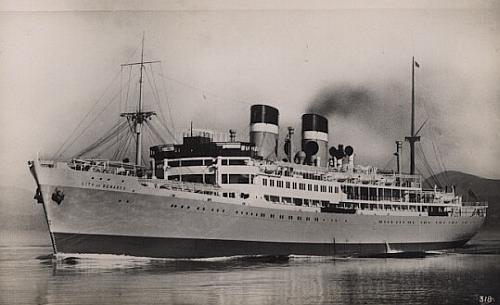
|
|
When a ship travels in convoy, as the City of
Benares did, it has to travel at the speed of the slowest vessel. Sadly
this proved to be the death, not only of the city of Benares, but 77
children travelling on her to Canada to escape the German bombing of
England, in particular, Liverpool. If she had ran solo, at speed, the
odds were that she would have made it safely across the Atlantic.
Liverpool in 1940 was a dangerous place. In the
height of World War II, during the German bombing campaign, whole areas
of the city were flattened, homes were destroyed and thousands were
killed.
The Liverpool docks were an integral part of the
Allied war effort. This caused Liverpool to become the most heavily
attacked English city outside of London. Families were desperate, trying
to protect their loved ones any way they could.
On Friday September
13, 1940 a passenger ship called City of Benares began its 2,500 mile
crossing of the North Atlantic. On board were around 400 people,
100 of which were children.
Designed for the tropical trip to Bombay, City
of Benares, accompanied by a navy destroyer, entered the rough seas
patrolled by German U-boats. "We'd hardly found our cabins when the alarm
bells went. That was our first lifeboat drill," remembered 14 year old
Beth Williams.
As the morning of the fourth day at sea dawned,
the passengers awoke to find their escort had left them - apparently now
safe to continue the journey alone.
U-48 was the most successful German submarine of
World War II, claiming thousands of tonnes of allied shipping.
Nineteen-year-old radio operator Rolf Hilse remembered, "We sunk
approximately 55 to 60 ships in the first two years of the war."
By September 17, 1940
it was 600 miles from the west coast of Ireland - lying beneath City Of
Benares. With no escort vessel Rolf said they didn't know it was a
passenger ship.
"The Captain said 'we
start in the middle as this is the biggest ship'. The torpedo
attack left 175 adults dead and of the 100 children on board only
13
survived.
|
| |
City of Benares was part of Convoy OB213 which was attacked apparently
before midnight on 17th September 1940 in the north Atlantic.
(56.48N/21.15W).
In the early hours of the 18th a single torpedo was fired at her by U48.
On board the liner were 90 children being evacuated to Canada escaping
the effects of the Blitz.
The sinking ship took on an immediate list preventing the launching of
many of the liferafts and trapping numerous crew and passengers below
decks. As a result, many of the 400 people on board were unable to
escape. As hundreds of survivors struggled in the water, the U~boat's
searchlight swept over the chaotic scene, before it left the area for
good.
The
survivors in the boats were not rescued for nearly 24 hours, as the
nearest allied units were 300 miles away, and in that time dozens of
children and adults died from exposure, or drowned, leaving only 147
survivors. One boat was not picked up for a further eight days. In total
255 people (including 77 of the evacuees) died.
Some of the children were killed in the explosion, some were trapped
in their cabins, and the rest died when the lifeboats were launched
incorrectly and children were just tipped into the sea.
All I can
remember were the screams and cries for help. It was one of the worst
disasters at sea concerning children, and it should always be
remembered.” David Bech. 9.
|
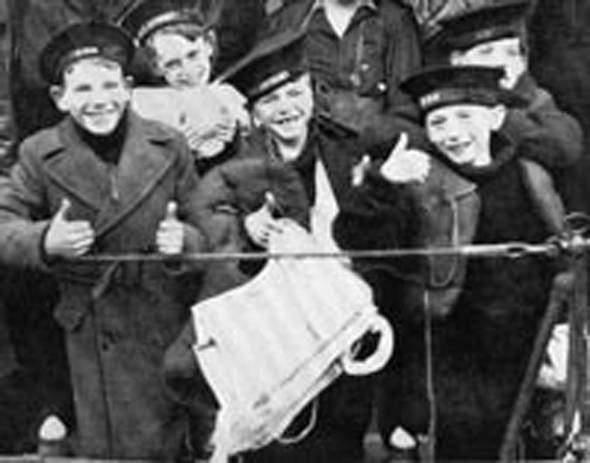
Left to right: Ken Sparks, Derek Capel and Fred Steels having survived 8
days adrift on lifeboat 12
Lifeboat 12 was left alone at sea as a result
of a lifeboat miscount. Its passengers had three weeks supply of food,
but enough water for only one week. In the lifeboat were approximately
30 Indian crewmen, a Polish merchant, several sailors, Mary Cornish,
Father Rory O'Sullivan (a Roman Catholic priest who had volunteered to
be an escort for the evacuee children), and six evacuee boys from the
CORB program. They spent eight days afloat in the Atlantic Ocean before
being sighted from the air and rescued by
HMS Anthony. |
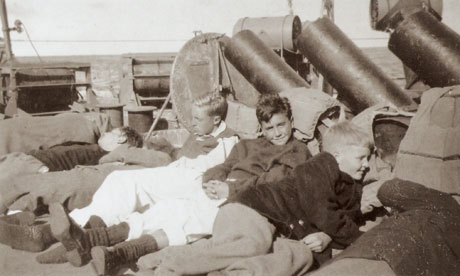
City of Benares - some of the survivors
|
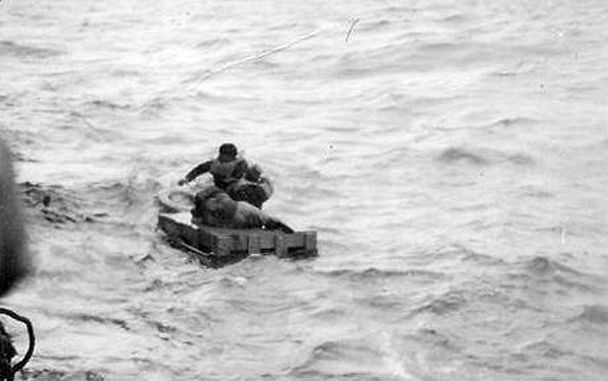 |
Port of
Registry: Glasgow
Propulsion: steam, turbines, single screw, 15 knots
Launched: Wednesday, 05/08/1936
Completed: October 1936
Built: 1936
Ship Type: Passenger Cargo Vessel
Tonnage: 11081 grt
Length: 486.2 feet (BP)
Breadth: 62.7 feet
Owner History:
Ellerman City Line Ltd Glasgow
Status: Torpedoed & Sunk - 18/09/1940
|
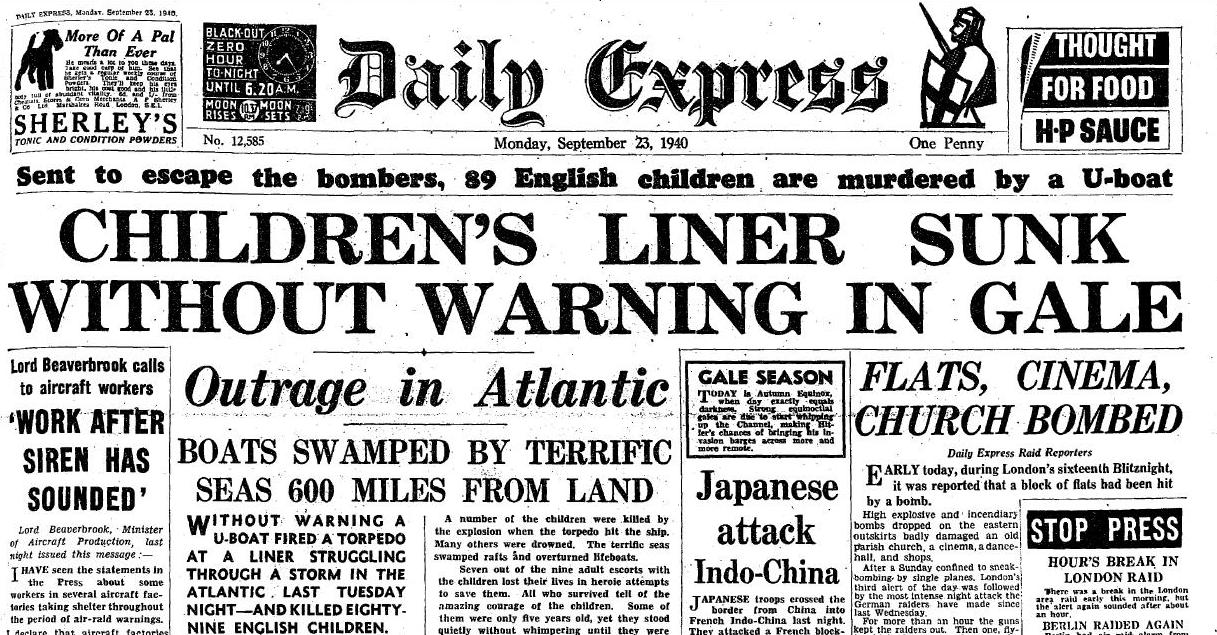
|
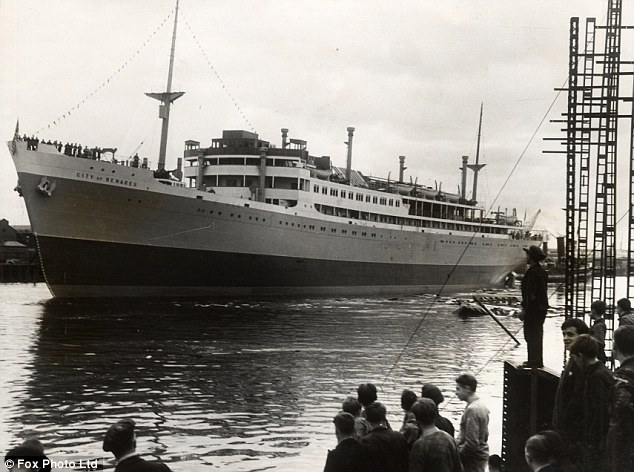
Benares at her launch in 1936
|
|
A report by the 4th officer, R M Cooper (as
printed in
http://www.shipsnostalgia.com/guides/City_of_Benares_(survivors_report)
On the night of the 17th September, at about
10pm GMT I was asleep in my bunk and was awakened by a dull explosion
and then the sound of alarm gongs. I dressed hurriedly and went along to
my boat station which was No. 12 lifeboat, where I found the Native
crews already mustered. I gave orders to clear away the boat, man the
falls and reels and stand by for lowering.
By this time one lady escort, Miss Cornish, had
brought 5 children to the boat, which was already lowered to the
embarkation deck. Shortly afterwards the male escort Mr. O’Sullivan,
arrived with one child and one passenger all of whom embarked in the
lifeboat. The assistant steward then reported that all children had been
cleared from the muster station in the Children’s playroom to their
allotted boats. I sent him to make a further search to ascertain if
there were any children asleep in their cabins. He returned and stated
that the cabins had been wrecked and the water being up to his waist he
shouted along the alleyway. Receiving no reply he assumed that there
were no children there.
There were now 18 children in the boat and 9 Europeans, and as the
vessel did not appear to be sinking very rapidly, I held on for
approximately a quarter of an hour in case any stragglers happened to
appear. All other port boats had now been lowered into the water so I
gave orders to lower away the boat which was launched in an orderly
manner. When the boat was safely in the water I ordered the 4 natives,
who had been standing by the falls, to get into the boat by means of the
side ladders, and also the Assistant Steward who had remained on deck.
After having a further search around the deck, I made my way into the
lifeboat and gave orders to ship the handles of the Fleming Gear which
were fixed to all our lifeboats. We then pulled away from the vessel.
Just as we were getting clear 4 natives appeared to be scrambling down
the lifelines and boat falls, so we put back and took them into the
boat. We then got clear and lay off until the vessel sank. At about 11pm GMT the vessel commenced to go
down stern first, raising her bow out of the water – she appeared to
list heavily to port, then disappeared.
Noticing a person in one of the rafts we went alongside and took him
aboard. It was the Naval Gunner Peards. I then steered over the position
where the vessel sank and came across a raft containing two Natives whom
I took on board. After this I sighted another raft; I pulled alongside
and took aboard 2 Europeans and 3 Natives, one of the Europeans being
Cadet Critchley and the other a Naval Signal Rating. About 10 yards away
we picked up another native who was floating in the water.
The boat now contained 6 children, 2 Escorts, 1 passenger, 1 Cadet, 1
Seaman gunner who was a member of the crew, the Assistant Steward, 1
Naval signalman, 32 Natives and myself.
There was a rough sea and heavy swell running. Noticing a light which I
took to be the rescue ship, I steered for it, but on approaching
discovered it to be another lifeboat, the occupants of which hailed us
and asked what ship. I replied CITY OF BENARES and they answered MARINA.
Seeing no sign of the remainder of our lifeboat’s, we kept company with
the MARINA’s lifeboat and steered in an Easterly direction before a
strong wind, keeping sea and swell astern. We continued in company until
dawn when the MARINA’s boat set sail, parting from us. As daylight came
I had the canvas hood rigged forward for the children, who were quite
snugly wrapped in blankets of which there were an ample supply in the
boat. The weather was so heavy that I decided not to set sail but
carried on by means of the Fleming Gear, setting the members of the crew
on watch. At noon I put all the occupants of the boat on food and water
rations, detailing the Assistant Steward to serve out the allocated
quantities.
On Thursday morning, the weather having moderated, we set the sail and
continued in an Easterly course intending to make the land if not picked
up meanwhile. On Friday afternoon the Westerly wind increased to gale
force with heavy rain and hail squalls with high sea. I decided to ride
to a sea anchor which was made fast in the after end of the boat, also
making use of the oil bags. We rode to the sea anchor for the remainder
of the day. My object in riding astern to sea was to endeavour to keep
the children and passengers dry as they were under the hood fitted in
the fore end of the boat.
At 4am on Saturday the 21st September, the wind and sea having abated a
little, we set sail again and continued on an Eastern course. At about
4pm on Sunday 22nd we sighted a vessel which we thought was going to
pick us up as she was heading in our direction. However, she altered
course and steered away from us and I thought afterwards that she must
have been zig zagging and may not have seen us.
The wind was again freshening and we continued under sail until about
6.30pm when the weather changed for the worse bringing frequent rain and
hail squalls. I decided to run out the sea anchor again to which we rode
stern first during the night. At daybreak, Monday the 23rd, the weather
had moderated to a light wind, moderate sea and swell. We hoisted sail
again and proceeded until 1pm Wednesday the 25th with a moderate W to
WNW wind. One of the boys sighted a Sunderland Flying boat which made
towards us and after circling 2 or 3 times communicated by means of the
Aldis lamp. The Naval Signalman replied by means of Semaphore but I do
not know whether the occupants of the ‘plane understood the signal. The
plane dropped a smoke flares with instructions to set it off when the
rescue ship was in sight, and he made off.
I then decided to lower the sail and heave to until assistance arrived.
About 2pm the flying boat again appeared and dropped a parcel containing
food, also a note telling us that assistance was on the way. At about
4.30pm we sighted a Destroyer coming, guided by the ‘plane. It was the
HMS ANTHONY and by 5 o’clock we were made fast alongside and got the
crew aboard without difficulty with the exception of one lascar who was
ill. The Destroyer’s MO attended to him in the lifeboat but he died
shortly after being taken aboard the Destroyer.
All the children were in good form, having, I think, looked upon the
whole thing as a picnic, and only one child was suffering from Trench
feet. We were all attended to by the Officers and men of the Destroyer
from whom we received every consideration and kindness. I hadn’t at any
time any anxiety regarding the food supplies in the boat as we had
plenty of tinned foods including meat, salmon and milk, and there was of
course the usual biscuits. However, I realised of course that if we
weren’t picked up before reaching land our water supplies would have to
be strictly rationed. We had already travelled 200 miles and were still
400 miles from land when picked up. The Children behaved splendidly and
were looked after very efficiently by Miss Cornish whom I believed
massaged them continuously. Throughout I had every assistance from the
passengers and crew. I was relieved at the tiller by Crichtley, the
Assistant Steward and the Naval Signalman and the Lascar Saloon boy,
Ramjan, was very good, proving most willing, helpful, and keeping the
other Lascars in good order.
Everyone behaved very well, and a spirit of loyalty to orders and
comparative cheerfulness prevailed throughout the entire 7 days and 19
hours which we were in the boat. We were landed at Greenock at 7pm on
the evening of the 26th September.
|
| |
Crew Casualties
|
| NICOLL, Landles |
Master (51) |
MN |
| ASHER, Hugh Hendry |
2nd Officer (39) |
MN |
| BAILEY, Annie |
Assistant Stewardess (36)
|
MN |
| BHICKOO, Abbas |
Seaman |
MN |
| CHARNOCK, Ernest |
Ordinary Signalman (24)
|
RN |
| COOK, Christian Sharp |
Chief Stewardess (52) |
MN |
| CUTHBERTSON, James |
6th Engineer (21) |
MN |
| FAIRWEATHER, Alister |
1st Radio Officer (40) |
MN |
| FLETCHER, Duncan |
Surgeon (67) |
MN |
| GEMMELL, James Alexander Walker
|
4th Engineer (24) |
MN |
| GIBBESON, John Cecil |
3rd Engineer (30) |
MN |
| LADYMAN, Margaret |
Nurse (49) |
MN |
| LAZARUS, John |
Wireless Operator (28) |
MN |
| LIVINGSTONE, Robert William
|
Quartermaster (42) |
MN |
| LUNT, Garath |
Quartermaster (20) |
MN |
| MACRAE, Donald |
5th Engineer (27) |
MN |
| MACKINNON, Edmond Julius Gordon
|
Commodore 2nd Class (60)
|
|
| MCLACHLAN, William |
Quartermaster (56) |
MN |
| MARSHALL, George |
Petty Officer Telegraphist
|
RN |
| MITCHELL, John Colville
|
Supernumerary 6th Engineer (19)
|
MN |
| ROBERTS, John |
Quartermaster (60) |
MN |
| SWALES, James |
Electrician (30) |
MN |
| SYMON, Frank |
Steward (27) |
MN |
| WALLACE, Agnes H |
Nurse (25) |
MN |
| ABDOOL, Allawoodeen |
Trimmer |
MN |
| ABOO, Abdul Latif |
Saloon Boy |
MN |
| ADAM, Esmail |
Seaman |
MN |
| AHMED, Jamal |
Saloon Boy |
MN |
| AHMED, Sk Esmail Sk |
Greaser |
MN |
| AJAD, Madaz |
Trimmer |
MN |
| ALFONSO, Jose |
General Servant |
MN |
| ALI, Mubarck |
Baker |
MN |
| ALLAB, Mussuljer |
N/K |
MN |
| ALLEE, Hasham |
Fireman |
MN |
| ALLEKHAN, Md Khan |
Fireman |
MN |
| AMEEN, Khotoo |
Greaser |
MN |
| AMEN, Sk Fakeer |
Seaman |
MN |
| AMJAD, Sk |
Steward |
MN |
| AYMOODIN, |
Fireman |
MN |
| AZIS, |
General Servant |
MN |
| BABA, Oosman |
Seaman |
MN |
| BABA, Oosman |
Seaman |
MN |
| BABOO, Pootu |
General Servant |
MN |
| BADROODEEN, Sulleyman |
Fireman |
MN |
| BALLA, Dawood |
Donkeyman |
MN |
| BALLA, Ebrahim |
Seaman |
MN |
| BAPOO, Sk Nooroodeen |
Seaman |
MN |
| BAWASH, Sk Ahmen |
Fireman |
MN |
| BHAKWA, Rustom Mussuljer
|
N/K |
MN |
| BUCKREEDY, |
Saloon Boy |
MN |
| BUXSH, Rahim |
Butler |
MN |
| CADER, Allesab |
Seaman |
MN |
| CALLOO, Sk |
General Servant |
MN |
| CHIKAPA, Ramswamy |
Topass |
MN |
| CURRIN SK, |
Saloon Boy |
MN |
| DAWOOD, Mahomed Sk |
Seaman |
MN |
| DERASTOOLA, |
Saloon Boy |
MN |
| DHARMO, Ak Hasson |
Seaman |
MN |
| DHONDOO, Oosman |
Fireman |
MN |
| EBRAHIM, Abdoolla |
Fireman |
MN |
| EBRAHIM, Mahomed |
Paniwallah |
MN |
| EBRAHIM, Sk Md Sk |
Trimmer |
MN |
| ESMAIL, Sheriff Sk |
Trimmer |
MN |
| ESMAIL, Sk Allee |
Trimmer |
MN |
| ESMAIL, Sowkat |
Serang |
MN |
| FACKEER, Rajack |
Fireman |
MN |
| FAZALDEEN, Sheir Md |
Fireman |
MN |
| FERNANDES, Manuel |
Assistant Steward |
MN |
| FERNANDES, Roque S |
Scullion |
MN |
| GHANI, Abdul |
Saloon Boy |
MN |
| GUNNY, Amon Abdool |
Trimmer |
MN |
| HASSON, Sk Hoosein Sk |
Winchman |
MN |
| HOOSEIN, Sk Adam Sk |
Bhandary |
MN |
| HOSSAINEE, |
Topass |
MN |
| HUQ, Abdul |
Saloon Boy |
MN |
| HUSSAIN, Mohd |
Saloon Boy |
MN |
| HYDERKHAN, Jafferkhan |
Fireman |
MN |
| JAFFER, Mahomed |
Fireman |
MN |
| JAN, Sk Md |
Saloon Boy |
MN |
| JNAUY, |
Topass |
MN |
| KAMALOODEEN, Sk Ahmed |
Greaser |
MN |
| KHALIQUE, Sk Abdul |
Saloon Boy |
MN |
| KHAMIE, Hasson |
Trimmer |
MN |
| KHOTOO, Sk Allee |
Fireman |
MN |
| LALOO, Sk |
Pantry Boy |
MN |
| LATIF, |
General Servant |
MN |
| LEITAO, Piedade C |
General Servant |
MN |
| MAHOMED, |
Barber |
MN |
| MAHOMED, Dawood |
Trimmer |
MN |
| MAHOMED, Shoosein |
Tindal |
MN |
| MAHOMED, Sk Hossein Sk |
Fireman |
MN |
| MANSOOR, Ismail |
Greaser |
MN |
| MOHAMDU, |
Pantryman |
MN |
| MOHIB, Bhandary |
N/K |
MN |
| MOJID, Abdul |
Saloon Boy |
MN |
| NAYKI, Nazroo Mahd |
Paniwallah |
MN |
| NOOROO, Sk |
Pantryman |
MN |
| NOZIR, |
Topass |
MN |
| OOSMAN, Abdooramon |
Cassab |
MN |
| OOSMAN, Sk Abass |
Tindal |
MN |
| OZONEULLA, Toimoosoolla
|
Greaser |
MN |
| PALMA, Benedic |
Cook |
MN |
| PANCHANDRA, Ramswamy |
Topass |
MN |
| PANCHCOWRIE, |
Topass |
MN |
| PANCHOO, |
Saloon Boy |
MN |
| PEREIRA, Espexian |
Butcher's Mate |
MN |
| PUNNA, |
Topass |
MN |
| RAHIM, Ebrahim Abdool |
General Servant |
MN |
| RAHMAN, Azizur |
Saloon Boy |
MN |
| RAZACK, Abdool |
Trimmer |
MN |
| RAZACK, Abdool |
Saloon Boy |
MN |
| ROSSUN, |
Saloon Boy |
MN |
| SAFEE, Mahomed Bhandary
|
|
MN |
| SHEERFOODEEN, |
Paniwallah |
MN |
| SOBAN, Abdool |
Captain's Boy |
MN |
| SOFEE, Mohomed |
Barber |
MN |
| SONA, |
Topass |
MN |
| SUBRAMANI, Rangswami |
Topass |
MN |
| SUKARAM, Gunpat |
Topass |
MN |
| SULEMAN, |
Saloon Boy |
MN |
| SULLEYMAN, |
Boy |
MN |
| SULTAN, Esmail |
Trimmer |
MN |
| TAJOODEEN, Allee |
Seaman |
MN |
|
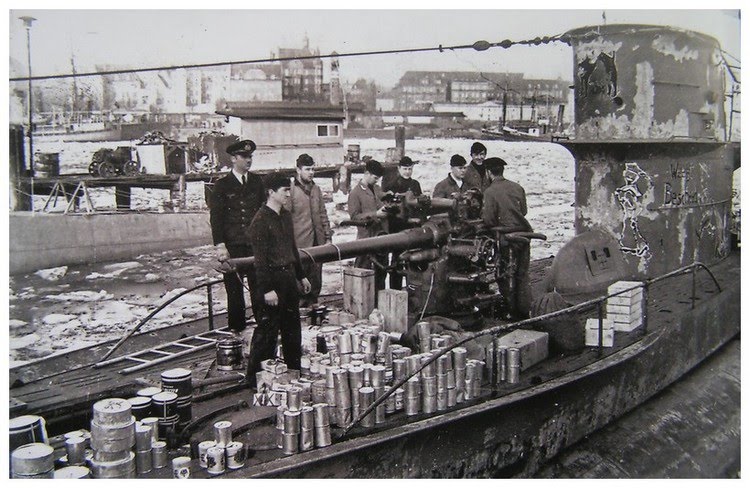
U 48 |
|
|







